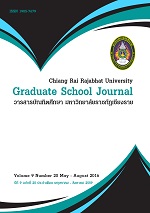汉语和泰语频率副词对比 及泰国学生使用汉语频率副词偏误分析
Main Article Content
บทคัดย่อ
通过对汉语和泰语频率副词的比较发现,在语义方面二者在表示的频率 上都有强弱之分,并且其表示频率又都具有不确定性。不同点在于:汉语和 泰语的频率副词数量并不相同,二者在语义上不能做到一一对应。在语法上, 相同点都是能做状语和定语,在有些时候还可以单独使用。不同点则在于其 修饰中心语的位置,汉语是前偏后正,泰语则是前正后偏。在单句中,汉语 的频率副词的位置比较靠近谓词,而泰语大多数情况出现在句末或句首。
通过对泰国学生学习汉语频率副词的问卷调查分析研究,发现泰国学生 在学习过程中主要出现的偏误类型为误代偏误和错序偏误。其产生偏误的主 要原因是母语的负迁移和学生学习的过度泛化。所以在教学过程中老师要引 导学生来学习,学生不能过度的泛化所学的知识,在出现错误时老师要及时 纠正。在学习过程中,让学生多做练习,从实践中慢慢的体会其语义和用法。
A Comparison of Adverbs of Frequency Between Chinese And Thai Languages And Error Analysis of Thai Students In Using Chinese Adverbs of Frequency
In this paper, we discussed the Chinese and Thai adverb of frequency, as well as semantic and syntactic features. We looked at the frequency of adverb between Chinese and Thai, and gave detailed comparative analysis that explored similarities and differences. We also discussed the theories that summarized the ways in which Thai students produced bias characteristics in the process of learning Chinese adverb of frequency, by looking into more details at the inductive types of errors, identifying the causes of errors, and finally proposing appropriate teaching strategies to eliminate these errors.
By comparing Chinese and Thai adverb of frequency, both in terms of the frequency of the semantic representation there are strong and weak points for both, which represented the frequency of uncertainty. The differences were that the number of adverb of frequency were not the same in Thai, as they were in Chinese, because the two languages did not correspond semantically. Syntactically, one needed to inspect the attributes of the adverbs, as they could be used alone in some cases. The difference was in the modification of the position of the center of language. In one sentence, the Chinese positioned adverb of frequency close to predicate, while the majority of Thai situated at the end of the sentence.
The Thai students learning Chinese by adverb of frequency’ questionnaire analysis found that the type of bias Thai students, in the learning process, was seen as wrong with an incorrect sequence generation bias. This bias is produced mainly due to the negative transfer and native language students of over-generalization. So , in the process of teaching with a Teachers To Guide, Students To Learn’ method, students stopped over-generalizing their knowledge learned, and in the event of an error the teacher must promptly correct. In the learning process, students did exercises and practice slowly to realize their accurate semantics and usage.
Article Details
บทความที่ได้รับการตีพิมพ์เป็นลิขสิทธิ์ของวารสารมหาวิทยาลัยราชภัฎเชียงราย
ข้อความที่ปรากฏในบทความแต่ละเรื่องในวารสารวิชาการเล่มนี้เป็นความคิดเห็นส่วนตัวของผู้เขียนแต่ละท่านไม่เกี่ยวข้องกับมหาวิทยาลัยราชภัฎเชียงราย และคณาจารย์ท่านอื่นๆในมหาวิทยาลัยฯ แต่อย่างใด ความรับผิดชอบองค์ประกอบทั้งหมดของบทความแต่ละเรื่องเป็นของผู้เขียนแต่ละท่าน หากมีความผิดพลาดใดๆ ผู้เขียนแต่ละท่านจะรับผิดชอบบทความของตนเองแต่ผู้เดียว


